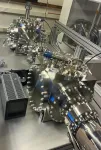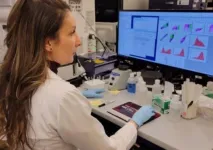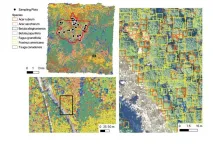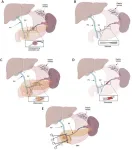(Press-News.org) SAN ANTONIO — July 16, 2024 — Researchers from Southwest Research Institute (SwRI) and The University of Texas at Dallas (UTD) are collaborating to evaluate a next-generation sensor designed to measure neutral gas velocities in the Earth’s upper atmosphere. The project, led by SwRI’s Dr. Joo Hwang and UTD’s Dr. Phillip Anderson, is supported by a grant from the new SwRI/UTD Seed Projects for Research, INnovation, and Technology (SPRINT) Program. Another SPRINT project is researching domestic lithium independence, looking at tectonic controls on critical emerging lithium deposits.
Geospace, the boundary region made up of the Earth’s upper atmosphere and nearby outer space, contains ionized and neutral components that are separately studied and defined as the ionosphere and thermosphere, respectively. Neutral winds largely drive the dynamics of the region, serving as the primary regulators and redistributors of the mass, momentum and energy and activating geospace weather at all latitudes.
“Understanding the dynamics of neutral wind and its coupling with ionospheric plasmas is critical for protecting military and commercial space-based assets in low Earth orbit from space weather events,” said Hwang, a staff scientist in SwRI’s Space Science Division. “We will leverage our new Molecular Beam Facility (MBF) to validate and enhance the measurement capabilities of UTD’s Neutral Wind Meter (NWM), establish development procedures, and significantly improve the signal-to-noise ratio.”
The project offers a unique opportunity to verify sensor performance and demonstrate its technical readiness level, which in turn makes the instrument more likely to be selected for upcoming missions. The integration of novel sensor technologies and molecular beam testing methodologies underscores a well-reasoned and innovative strategy to address critical gaps in understanding space weather impacts.
“Protoflight sensor hardware has been constructed and tested in the laboratory environment, and numerical simulations have confirmed the instrument’s operational principles and robust approach for measuring neutral gas velocities. The opportunity to test it in an environment that simulates the actual conditions in space is extremely valuable,” said Anderson, director of UTD’s William B. Hanson Center for Space Sciences. “A version of our instrument scheduled to fly for the first time on a rocket in 2025 will be evaluated at SwRI early next year.”
The only other MBF is at the University of Bern in Switzerland. SwRI has leveraged its unique expertise to establish a molecular beam accelerator at its San Antonio headquarters to meet the critical necessity for a domestic facility to verify the functionality and effectiveness of similar space sensors.
The facility creates a neutral gas beam at velocities of 3-6 kilometers per second, temperatures up to 1,000 C and pressures of hundreds of pounds per square inch to simulate the motion of instruments in tenuous atmospheres. A small 10-micron opening delivers a narrow beam of gas into the expansion chamber where the central portion of the beam is extracted by a skimmer with a one-millimeter orifice and a filter that can create a higher velocity tail. Adjusting the nozzle-skimmer distance controls the beam’s downstream width and flux, while large turbomolecular pumps maintain high vacuum.
“SwRI will optimize settings for UTD’s NWM, determining the velocity filter settings needed to create a molecular beam close to the relative velocity of the neutral gas spacecraft experience in low-Earth orbit,” Hwang said. “Through dedicated testing with updated software, MBF will verify/support the measurement capabilities of UTD’s NWM.”
SwRI’s Executive Office and UTD’s Office of Research and Innovation developed SPRINT to enhance greater scientific and engineering collaboration between the two institutions. This program provides opportunities for researchers to work together, addressing issues of mutual interest and need while bringing together the capabilities, facilities and expertise from both organizations. Funded projects include at least one principal investigator from each institution.
For more information, visit https://www.swri.org/heliophysics.
END
SwRI, UTD jointly fund project to evaluate space sensor in unique facility
SPRINT program launches, also funds domestic lithium independence research
2024-07-16
ELSE PRESS RELEASES FROM THIS DATE:
Nature-based solutions to disaster risk from climate change are cost effective, UMmass Amherst study confirms
2024-07-16
AMHERST, Mass. – A new global assessment of scientific literature led by researchers at the University of Massachusetts Amherst finds that nature-based solutions (NbS) are an economically effective method to mitigate risks from a range of disasters—from floods and hurricanes to heatwaves and landslides—which are only expected to intensify as Earth continues to warm.
NbS are interventions where an ecosystem is either preserved, sustainably managed or restored to provide benefits to society and to nature. For instance, they can mitigate risk from a natural disaster, or facilitate climate mitigation and adaptation. NbS ...
Decline in global adolescent fertility rates is counteracted by increasing teen births in Sub-Saharan Africa
2024-07-16
July 16, 2024-- A new report from Columbia University Mailman School of Public Health and the Columbia Aging Center with colleagues from the Norwegian Institute of Public Health highlights a troubling trend: while global adolescent fertility rates have significantly declined, sub-Saharan Africa is experiencing an increase in teen births. This region's share of global adolescent births surged from 12 percent in 1950 to 47 percent in 2020 and is projected to reach a clear majority – a full 67 percent - by ...
Apps and AI could help personalize depression diagnosis and treatment
2024-07-16
New research at the University of Illinois Chicago is testing whether digital tools can help predict which patients with depression will benefit from specific treatments and help deliver those treatments to them on demand.
Two new grants awarding over $10 million to UIC will help Dr. Jun Ma and colleagues in the College of Medicine investigate the use of a smartphone app, an AI voice assistant and other technologies to diagnose and treat depression.
The researchers hope these tools will both broaden access to psychiatric care and ...
Researchers create new template of the human brain
2024-07-16
The human brain is responsible for critical functions, including perception, memory, language, thinking, consciousness, and emotions.
To understand how the brain works, scientists often use neuroimaging to record participants’ brain activity when the brain is performing a task or at rest. Brain functions are systematically organized on the cerebral cortex, the outer layer of the human brain. Researchers often use what is called a "cortical surface model" to analyze neuroimaging data and study the functional organization of the ...
Study identifies protein that helps COVID-19 virus evade immune system
2024-07-16
An article published in the journal Cell describes a study that enabled a group of researchers to discover how SARS-CoV-2 evades the cytotoxic immune response by identifying a protein called ORF6 that is a key factor in this mechanism.
The cytotoxic immune response involves T-lymphocytes that kill pathogens when they recognize cells bearing a specific antigen while sparing neighboring uninfected cells.
The study was led by Wilfredo Garcia-Beltran and Julie Boucau, research scientists at the Ragon ...
Scientists use machine learning to predict diversity of tree species in forests
2024-07-16
A collaborative team of researchers led by Ben Weinstein of the University of Florida, Oregon, US, used machine learning to generate highly detailed maps of over 100 million individual trees from 24 sites across the U.S., publishing their findings July 16th in the open-access journal PLOS Biology. These maps provide information about individual tree species and conditions, which can greatly aid conservation efforts and other ecological projects.
Ecologists have long collected data on tree species to better understand a forest’s unique ecosystem. Historically, this has been done by surveying small plots of land and extrapolating those findings, though this cannot account for ...
Machine learning helps define new subtypes of Parkinson’s disease
2024-07-16
Researchers at Weill Cornell Medicine have used machine learning to define three subtypes of Parkinson’s disease based on the pace at which the disease progresses. In addition to having the potential to become an important diagnostic and prognostic tool, these subtypes are marked by distinct driver genes. If validated, these markers could also suggest ways the subtypes can be targeted with new and existing drugs.
The research was published on July 10 in npj Digital Medicine.
“Parkinson’s disease is highly heterogeneous, which means that ...
Weight loss influences risky decisions in obesity
2024-07-16
People who are severely overweight (obese) not only exhibit altered risk behavior, but also changes in their metabolism and psyche. It was previously assumed that severely obese people are more impulsive and show an increased willingness to take a risk. Scientists from the DZD partner German Institute of Human Nutrition Potsdam-Rehbrücke (DIfE) have now investigated whether massive weight loss leads to an improvement in metabolic and psychological states and whether decision-making is improved. The results were published in the journal 'Clinical Nutrition'.
Being overweight can cause metabolism to slip
Our behavior depends on many factors. ...
EurekAlert! Travel Awards recognize early-career science journalists in Eastern Europe for the first time
2024-07-16
The winners of the 2024 EurekAlert! Travel Awards are Pavla Hubálková, a Czech science journalist at WIRED.CZ, and Iris Duțescu, a Romanian freelance science journalist.
An independent panel of three judges with regional science journalism expertise selected the winners. Both awardees will receive travel support from EurekAlert! to attend the 2025 Annual Meeting of the American Association for the Advancement of Science (AAAS) in Boston, Mass., where they will have opportunities to cover the latest scientific research and make connections with scientists ...
Etiologies of splenic venous hypertension
2024-07-16
Splenic venous hypertension (SVH), also known as left-sided portal hypertension, is a rare condition characterized by upper gastrointestinal (GI) bleeding in the absence of liver disease. This condition arises due to increased pressure in the splenic vein (SV), causing blood to drain through the short gastric veins to the stomach, leading to the dilation of submucosal structures and the formation of gastric varices. Unlike traditional portal venous hypertension (PVH), SVH does not involve elevated pressures in the main portal vein and is primarily an extrahepatic condition. Diagnosing SVH requires ...
LAST 30 PRESS RELEASES:
Numbers in our sights affect how we perceive space
SIMJ announces global collaborative book project in commemoration of its 75th anniversary
Air pollution exposure and birth weight
Obstructive sleep apnea risk and mental health conditions among older adults
How talking slows eye movements behind the wheel
The Ceramic Society of Japan’s Oxoate Ceramics Research Association launches new international book project
Heart-brain connection: international study reveals the role of the vagus nerve in keeping the heart young
Researchers identify Rb1 as a predictive biomarker for a new therapeutic strategy in some breast cancers
Survey reveals ethical gaps slowing AI adoption in pediatric surgery
Stimulant ADHD medications work differently than thought
AI overestimates how smart people are, according to HSE economists
HSE researchers create genome-wide map of quadruplexes
Scientists boost cell "powerhouses" to burn more calories
Automatic label checking: The missing step in making reliable medical AI
Low daily alcohol intake linked to 50% heightened mouth cancer risk in India
American Meteorological Society announces Rick Spinrad as 2026 President-Elect
Biomass-based carbon capture spotlighted in newly released global climate webinar recording
Illuminating invisible nano pollutants: advanced bioimaging tracks the full journey of emerging nanoscale contaminants in living systems
How does age affect recovery from spinal cord injury?
Novel AI tool offers prognosis for patients with head and neck cancer
Fathers’ microplastic exposure tied to their children’s metabolic problems
Research validates laboratory model for studying high-grade serous ovarian cancer
SIR 2026 delivers transformative breakthroughs in minimally invasive medicine to improve patient care
Stem Cell Reports most downloaded papers of 2025 highlight the breadth and impact of stem cell research
Oxford-led study estimates NHS spends around 3% of its primary and secondary care budget on the health impacts of heat and cold in England
A researcher’s long quest leads to a smart composite breakthrough
Urban wild bees act as “microbial sensors” of city health.
New study finds where you live affects recovery after a hip fracture
Forecasting the impact of fully automated vehicle adoption on US road traffic injuries
Alcohol-related hospitalizations from 2016 to 2022
[Press-News.org] SwRI, UTD jointly fund project to evaluate space sensor in unique facilitySPRINT program launches, also funds domestic lithium independence research





